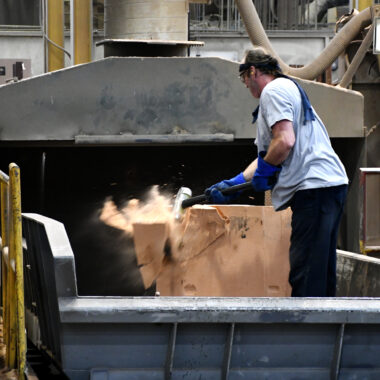Grasping Aluminum Casting: Proven Techniques to Enhance Manufacturing Efficiency
Wiki Article
Dive Into the World of Light Weight Aluminum Casting: Comprehending the Various Techniques
Aluminum spreading is a fundamental procedure in the manufacturing sector, with numerous approaches employed to develop detailed and precise parts. Understanding the various techniques made use of in aluminum casting can supply beneficial understandings right into the capacities and restrictions of each technique. From the traditional sand spreading technique to the sophisticated die spreading process, each technique supplies special benefits depending on the demands of the project. Discovering these diverse methods can use a comprehensive sight of the possibilities within the globe of light weight aluminum casting and just how each strategy adds to forming the modern-day production landscape.Sand Spreading Method
Sand casting, a widely-used method in aluminum spreading procedures, entails creating molds made from compacted sand for pouring molten metal. This approach is very flexible and economical, making it a preferred selection for different sectors. The procedure begins with the development of a pattern, commonly made of wood or steel, which is after that pushed into the sand to leave a perception. The sand combination, commonly silica sand combined with a binder like clay, is firmly loaded around the pattern to form a mold and mildew tooth cavity. Once the mold prepares, it is firmly placed in a flask and molten aluminum is put right into the tooth cavity.After the steel has cooled and strengthened, the sand mold and mildew is escaped to reveal the aluminum spreading. Sand casting enables for the manufacturing of complex shapes and large components that may be challenging or expensive to produce making use of various other techniques. It is additionally a sustainable method as the sand can be recycled and utilized numerous times, reducing waste in the spreading process.
Irreversible Mold And Mildew Method

One substantial advantage of the Long-term Mold And Mildew Technique is the boosted dimensional precision it supplies. The metal mold and mildew permits tighter tolerances and finer details in the final light weight aluminum castings contrasted to sand casting approaches. This accuracy makes it a recommended choice for applications where tight dimensional control is critical, such as in the automobile and aerospace industries.

Pass Away Casting Process

Financial Investment Casting Strategy
Utilizing an accuracy casting technique, Investment Casting Approach entails producing complex aluminum components by putting molten steel into a ceramic mold and mildew. This procedure, likewise known as lost-wax spreading, begins with the production of a wax pattern of the preferred component (aluminum casting).The following step involves pouring the molten light weight aluminum into the ceramic mold and mildew. The aluminum loads the tooth cavity left by the wax pattern, taking its form exactly. This method is preferred for its ability to create complex forms with high accuracy and a smooth surface coating. Investment spreading is typically made use of for making elements in sectors where complex designs and tight resistances are needed, such as aerospace, auto, and medical devices. The convenience and precision of the Financial investment Casting Approach make it a useful strategy in the world of aluminum spreading.
Lost Foam Casting Approach
Having actually checked out the intricate precision of Financial investment Casting Method, the focus currently changes to the cutting-edge method of Lost Foam Casting in light weight aluminum part production. Lost Foam Spreading, additionally referred to as evaporative pattern spreading, is a modern method where a foam pattern of the preferred component is created visit homepage and after that covered with a refractory product. The covered foam pattern is after that buried in sand, and molten aluminum is poured right into the mold and mildew. As the steel fills up the mold and mildew, the foam evaporates because of the heat, leaving a tidy tooth cavity in the form of the desired part.Furthermore, Lost Foam Casting is a cost-efficient process as it lowers the need for cores and permits for the production of light-weight parts. Regardless of its advantages, Lost Foam Spreading needs mindful control of the casting procedure to make certain and avoid issues quality elements.
Verdict
In conclusion, light weight aluminum spreading supplies a variety of techniques such as sand spreading, permanent mold method, die casting, investment spreading, and lost foam casting. Each approach has its own advantages and applications, making light weight aluminum casting a versatile and widely utilized procedure in various markets. Recognizing the distinctions in between these methods is important in picking one of the most suitable casting method for particular manufacturing needs.Sand spreading, a widely-used approach in aluminum casting processes, involves creating molds made of compressed sand for putting liquified steel. aluminum casting.The Long-term Mold Method, like sand spreading, is one more common method utilized in aluminum casting procedures, providing distinctive benefits in terms of mold and mildew reusability and dimensional precision. The steel mold and mildew allows for tighter tolerances and finer information in the last light weight aluminum spreadings contrasted to sand casting approaches. The 2 primary kinds of die casting are cool chamber die spreading and warm chamber die casting, each ideal for various types of aluminum alloys.In conclusion, aluminum casting uses a selection of approaches such as sand casting, permanent mold strategy, pass away casting, investment casting, and lost foam casting
Report this wiki page